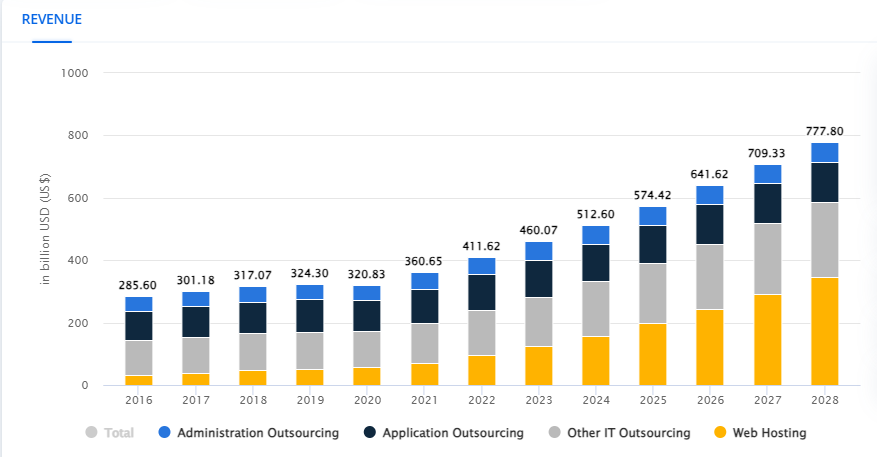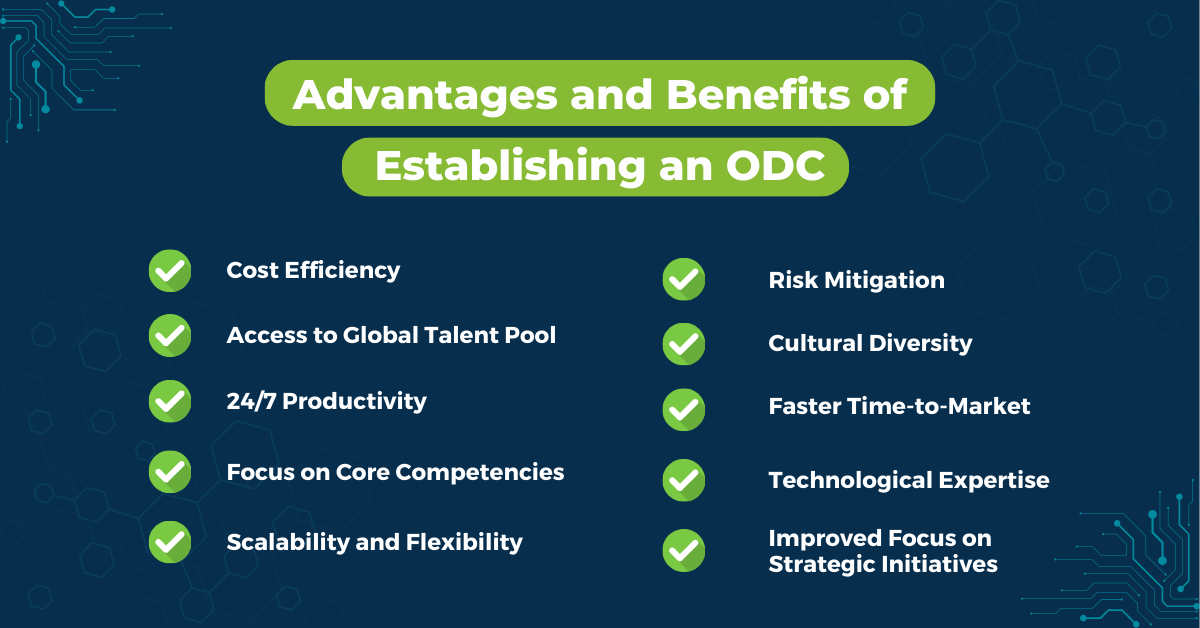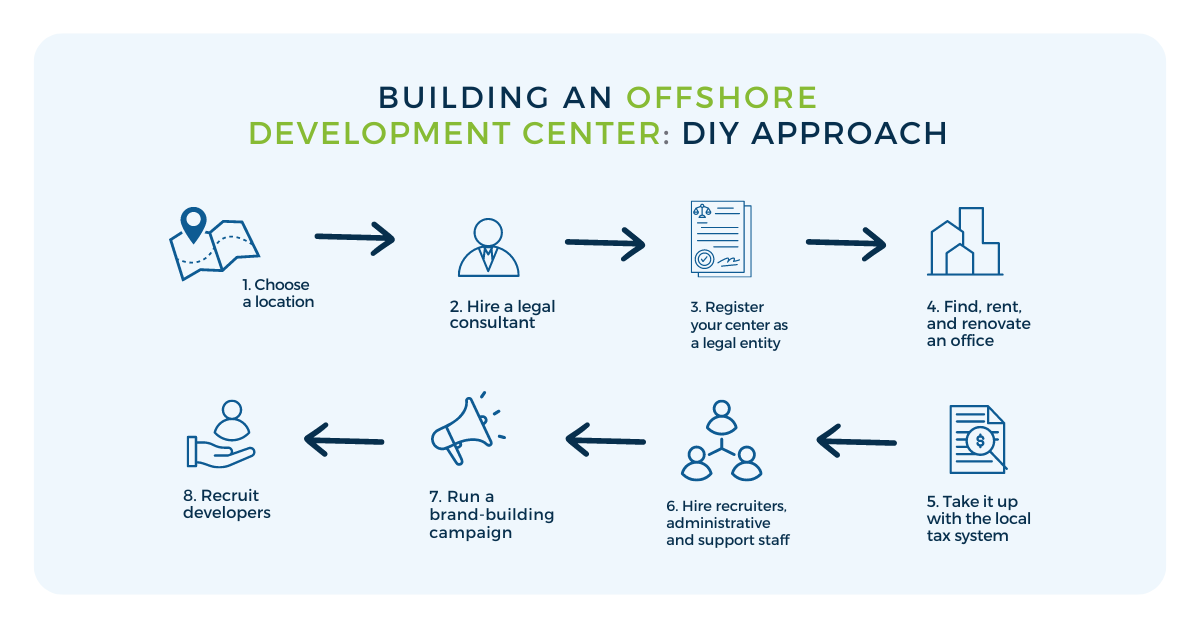Across the IT industry, companies are increasingly accustomed to integrating team members who do not share office space—or even time zones—with the main headquarters.
Within the context of software development, an Offshore Development Center (ODC) allows you to scale quickly, increasing or reducing your staff at need by partnering with individual developers or even entire software development teams who live in a country with whom you don’t share borders.
Whether these developers live in Asia or Eastern Europe, ODC’s allow you to scale according to your current goals and project needs, making them an attractive option. However, ODC’s are not a magic bullet, nor are they right for everyone.
If you’re considering working with an Offshore Development Center for your next project, you’ll want to do your due diligence and make sure it’s really the right move.
And we’re here to help.
In this post, we will
- Provide an overview of what Offshore Development Centers look like
- Outline key roles and responsibilities within an offshore development team
- Discuss distinct advantages and disadvantages of pursuing offshore development
- Outline how to successfully set up and manage ODC’s
- Weigh the pro’s and con’s of offshore development vs. nearshore development
- Help you determine whether an offshore development service is the right move for your next project
Through it all, bear in mind that whatever your current software outsourcing needs, ParallelStaff is here to help meet them.
What Is an Offshore Development Center?
An Offshore Development Center (ODC) refers to a strategic model in which organizations leverage a dedicated team of highly skilled professionals set up in a different location and time zone from headquarters.
While managed by a Partner organization, these teams are integral to achieving key business goals. This arrangement may resemble traditional outsourcing, but with a crucial distinction: unlike outsourcing, which can occur within the same country, an ODC is inherently international, capitalizing on global talent pools to optimize operations and innovate beyond borders. Essentially, ODCs represent the evolution of outsourcing into a globally dispersed, yet tightly integrated, component of modern business strategy. (Zinnov)
The beauty of ODCs is that they can serve as extensions of your company’s current development capabilities. You and your team are already good at what you do. Imagine what you could be capable of with access to the global talent pool!
And the good news is that Offshore Development Centers are not a one-size-fits-all situation. Depending on your current needs, you could pick from one of three different models.
Current ODC Models
The Build-Operate-Transfer (BOT) Model is one of the most popular ODC models.
With the BOT model, a software company will hire a team on a contractual basis to build an IT service, bring it into operation, and then transfer the operation back to the software company that hired them.
A BOT Model could involve literally starting from scratch (starting with setting up facilities, hiring an offshore team yourself, etc.) or working within an existing infrastructure to start building your IT product or service.
The BOT model has a proven history of saving time and money while still helping move projects to market faster. However, the initial set-up costs can be very high.
With the Dedicated Development Team Model, a software company will hire a team of remote experts to develop a project remotely, adhering to a strict set of pre-set project goals. During the time of their contract, this dedicated development team will work exclusively on your project under the direction of a remote project manager.
The costs to work with a Dedicated Development Team are nowhere near as high as the BOT Model and it ensures consistent quality control for your product, making it an attractive and accessible choice.
Similarly, the Project-Based Model allows software companies to manage software development outsourcing aspects of specific projects—or entire projects themselves—to a pre-established Offshore Development Center.
This is an ideal choice for startups, small to midsize companies, or even just smaller projects with shorter time frames that would not require the care and attention of an entire dedicated team—or the associated budget that would require.
Current Countries Known for Hosting ODC’s
If you’re looking for an ODC, you certainly won’t have trouble finding one. The IT outsourcing market is projected to reach US$146.10 in 2024, accounting for nearly 16% of all outsourcing worldwide.

While ODC’s crop up around the world, there are certain countries making a name for themselves as reliable sources of ODC’s for US-based IT companies.
Countries in Asia:
-
- India. As a massive subcontinent, India is home to 4 million software developers.
- The Philippines. Filipino development teams are famous for high satisfaction rates.
- China. China boasts a booming IT market with a large talent pool.
- Singapore. With strong government support, the tech sector in Singapore is thriving.
-
- Vietnam. Though small in terms of geography, Vietnam is a mighty player in the Asian tech world, home to top-quality software developers, over 54% of whom are proficient in English.
Other Asian countries home to ODC’s include Malaysia, Taiwan, Bangladesh, and Thailand.
Countries in Eastern Europe:
- Poland. Poland is currently emerging as an IT industry leader in Eastern Europe.
- Ukraine. The number of skilled developers in Ukraine increases every year, and despite the country’s current challenges, the Ukranian IT sector was still performing well when compared to the rest of the global talent pool.
- Czech Republic. High-quality, low-cost developers and software engineers make the Czech Republic an attractive prospect for an Offshore Development Center.
- Romania. Romanian development teams have earned a solid reputation in the global IT market.
- Hungary. Hungary currently enjoys a high global tech ranking, making the country a solid choice for an ODC.
Key Roles and Responsibilities in ODC’s
Within the ODC model, to prevent confusion, overlap, or wasted time, a clear delineation of key roles and responsibilities is critical.
That makes defining key roles and responsibilities one of the most important steps in the ODC setup phase.
Key roles within the remote team include:
- Project Managers are responsible for overseeing the software development process, ensuring that the team fulfills their roles and keeps to the project schedule and requirements. Project managers oversee practical tasks related to maintaining clear communication, delegating tasks, and setting deadlines.
- Software Engineers create, test, and deploy the product, software, or service.
- Quality Assurance Analysts continuously test the product to ensure the highest standards.
- Business Analysts bridge the gap between the vision and implementation of the project to ensure maximum profitability.
By contributing according to their individual strengths, each member of the ODC team ensures the success of the project as a whole.
5 Offshore Development Center Benefits

There’s a reason why ODCs have become increasingly popular. They carry five distinct advantages.
Advantage 1: Savings Through Lower Labor Costs
Because of cost-of-living differences around the world, US-based IT companies can afford to pay offshore developers well within the context of their own economic situations and still enjoy significant cost savings.
Though there are many variables involved, your savings could be anywhere from 50-70%.
Advantage 2: Access to a Large Talent Pool
As we’ve already mentioned earlier in this article, one of the main advantages of establishing an Offshore Development Center is that you gain access to the global talent pool. This means that whether you have a massive cloud computing project or there’s a mobile app development team that needs to be quickly deployed, your options are nearly endless.
While hiring locally will limit your scope to whoever is currently available in your immediate area, setting up an ODC removes those limits.
Advantage 3: Round-the-clock Development
While there are some challenges associated with establishing an ODC in a vastly different time zone, there’s also one definite advantage.
The sun never sets on your development progress!
Advantage 4: Scalability and Flexibility in Resource Allocation
There’s something magical about how an ODC allows you to scale and downsize your team as needed:
ODCs offer scalability that is often difficult to achieve with in-house teams. You can easily scale up or down your ODC team size based on project requirements, which is particularly useful for handling fluctuating workloads.
Advantage 5: Focus on Core Business Activities
With an offshore development center service working on your behalf, your team in the home office can bend their entire focus on your core business activities.
This allows you to speed up your product development process in a more cost-effective way without burning the midnight oil and stretching your team too thin!
5 Challenges in Offshore Development
The fact that there are distinct advantages to setting up Offshore Development Centers does not mean the approach is not without potential pitfalls.
There are definite risks involved in establishing ODC’s.
Challenge 1: Cultural and Language Barriers
In contrast to nearshoring, when software development companies partner with offsite developers with whom they share close proximity, offshore software developers may live half a world away, speak different languages, and hold drastically different cultural values.
While these barriers can certainly be overcome, they often add an extra layer of difficulty atop an already daunting task.
Challenge 2: Communication Challenges
Unfortunately, communication challenges are central to the ODC experience.
Asynchronous communication can add large time lags, and any synchronous communication you do enjoy is often hindered by language, culture, and distance.
Challenge 3: Time Zone Differences
Unlike with nearshore software development partners, who may be in your same time zone or just an hour or two away, remote Offshore Development Centers may have anywhere from a six to sixteen-hour time difference from your home office.
Not exactly a recipe for fast and effective collaboration.
Challenge 4: Intellectual Property Protection
This is perhaps one of the most concerning challenges with ODC’s.
While some countries have very strong privacy laws and IP protections in place to help protect your concerns, others do not (or have them in name only).
Protecting your intellectual property may be challenging, but there are important steps you can take, such as copyrighting and encrypting your software, preparing licensing agreements, and establishing and communicating strong penalties for breaches in advance.
Challenge 5: Legal and Regulatory Compliance
When international laws come into play, legal and regulatory compliance issues are on another level.
Hiring a compliance officer (or entire team!) to implement a strong compliance management system with regular audits and assessments could help mitigate your risks in working with offshore developers.
4 Steps to Successfully Set up and Manage ODCs

If you’ve decided an Offshore Development Center is right for you, getting started might sound overwhelming.
At this point, it may be helpful to break down the process of establishing and overseeing ODC teams into specific steps.
Step One: Select the right location and provider.
After researching regions and narrowing down on a specific country within that region, research current providers, looking closely at things like the ODC’s reputation, what they specialize in, and whether they can demonstrate a strong proof of concept.
Step Two: Define project goals and requirements.
From the outset, set your expectations in very clear terms.
- Scope of the project
- Lines of communication
- Timelines and deliverables
- Responsibilities of the ODC team
Step Three: Establish clear communication channels.
While communication will nearly always prove challenging when partnering with ODC teams, clear communication channels can help you optimize your time.
-
- Implement project management tools. Tracking progress through tools like Asana, Slack, Trello, or Jira can streamline your efforts and simplify communication among members of the team.
-
- Conduct regular performance reviews and feedback sessions. Don’t just meet when you need to put out a fire. Routine performance reviews and regularly scheduled feedback sessions can help you and your team stay ahead of issues and solve potential issues before they come to a head.
Step Four: Implement effective ODC management strategies.
Successful ODC relationships don’t happen by accident. They’re a direct result of effective management strategies that foster core values.
-
- Promoting company culture. It’s much easier to work together on a team when everyone is clear on what that team stands for.
- Ensuring cultural sensitivity. Foster an environment that understands and celebrates differences.
- Offering cross-cultural training. Recognizing the sources of one another’s cultural differences naturally lowers friction and leads to more intentional give-and-take among team members.
- Using agile methods for flexibility. Agile teams adapt easily to changing circumstances.
- Setting clear issue-escalation paths. Nothing kills a project—or teamwork—quite like unclear escalation procedures. Clear escalation paths help teams resolve issues quickly while working together to stay on track!
Offshore vs. Nearshore Development Center
Though the terms sound similar, there are distinct and important differences between Offshore Development Centers—which have been detailed extensively in this article–and Nearshore Development Centers.
While ODC’s will have you partnering with custom software development teams on the other side of the world, nearshore development involves outsourcing software development tasks to tech talent in countries close to the client’s location.
For those in the United States, nearshore partners may reside in Latin American (LATAM) countries such as
- Mexico
- Costa Rica
- Colombia
- Argentina
- Brazil
- Chile
- Peru
In contrast to offshoring, nearshoring is a popular choice due to a number of important factors. Because nearshore partners live in close proximity to the parent company, developers generally share significant overlaps in culture and language. As an added bonus, they likely also share similar time zones.
As you’ve likely already guessed, thinking in similar ways, sharing languages in common, and keeping synchronous work hours are all elements that help nearshore partners speed your project to completion.
For these factors alone, Nearshore Development Centers and partnerships with nearshore dedicated teams are as good an option—if not better!—than an Offshore Software Development Center.
Is Offshoring the Right Move for Your Business?
If you’re seriously considering offshoring some (or all) of the work on your next IT project, your first step should involve weighing the pro’s and con’s of both options, always taking into consideration three key factors.
Consideration 1: The Project Scope
What are your goals, deadlines, and deliverables for this project?
If the scope of the project requires staff augmentation, offshoring might be the right move.
Consideration 2: Current Budget Constraints
While some offshore countries may look as if they offer more significant savings up front, don’t forget to factor in what they may cost you in terms of higher time and financial costs over the long haul due to the great distances that separate you (longer and more expensive travel for in-person visits, communication delays due to time zone differences, etc.).
Consideration 3: Long-term Strategic Objectives
If, ideally, you’re looking to establish a partnership that outlasts a single project, take time to consider the potential long-term sustainability of the working relationship.
If that’s your goal, seriously consider nearshore staff augmentation instead.
As we’ve already noted above, nearshoring offers significant benefits that offshoring cannot. Things like shared culture, similar languages, and compatible time zones lead to reduced logistical challenges that can lead to hidden cost savings over time.
This is exactly why we do what we do.
As a skilled and experienced nearshore software development solution provider with a healthy track record of successes, ParallelStaff can help you assemble your own Nearshore Development Center. Connect with results-driven teams in your timezone to deliver and launch products faster.
Book a call to learn more and get started today!






